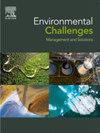利用机器学习进行加纳白沃尔特盆地洪水管理和缓解的流量预测
Q2 Environmental Science
引用次数: 0
摘要
洪水是加纳怀特沃尔特盆地生计和基础设施的主要威胁。提供准确的流量信息对洪水管理和缓解至关重要。这项研究首次使用机器学习算法,特别是长短期记忆(LSTM)和随机森林(RF),对降雨、温度、土壤湿度和蒸散数据进行训练,以预测White Volta盆地1、5和10天的间隔流量。研究进一步利用这些模型(RF和LSTM),利用CMIP6 SSP5-8.5情景数据预测未来的流量。模型的输出主要用平均绝对误差、平均偏倚误差和克林-古普塔效率来评价。结果表明,水流具有很高的可变性,两个模型都能很好地捕捉这些可变性。LSTM在捕获峰值流量方面表现更好,而RF提供了长达10天的稳定长期预测。对未来的预测也显示了河流流量的高度变化,表明白沃尔特盆地发生洪水和干旱的风险增加。鉴于这些模型可以捕捉到水流的时间(季节性模式和峰值),它们可以提供准确可靠的预测,以支持流域有效的洪水风险管理和缓解。这些模型可以推广到类似的流域,为主动洪水预警提供可复制和可持续的框架。本文章由计算机程序翻译,如有差异,请以英文原文为准。

Streamflow forecasting using machine learning for flood management and mitigation in the White Volta basin of Ghana
Floods are a major threat to livelihoods and infrastructure in the White Volta basin of Ghana. Providing accurate streamflow information is essential for flood management and mitigation. This study, for the first time, used machine learning algorithms, specifically the Long Short-Term Memory (LSTM) and Random Forest (RF), trained on rainfall, temperature, soil moisture, and evapotranspiration data to predict streamflow at 1, 5, and 10-day intervals in the White Volta basin. The study further used these models (RF and LSTM) to forecast future streamflow using CMIP6 SSP5–8.5 scenario data. The model’s output was mainly evaluated using Mean Absolute Error, Mean Bias Error, and Kling-Gupta Efficiency. The result showed high variability in the streamflow, and both models performed well in capturing these variabilities. LSTM performed better in capturing peak flows, whereas RF provided stable long-term predictions for up to 10 days. The future predictions also showed high variability in streamflow, suggesting an increased risk of floods and droughts in the White Volta basin. Given that these models can capture the timings of streamflow (seasonal patterns and peaks), they are well-positioned to provide accurate and reliable forecasts to support effective flood risk management and mitigation in the basin. These models can be extended to similar basins, offering a replicable and sustainable framework for proactive flood early warnings.
求助全文
通过发布文献求助,成功后即可免费获取论文全文。
去求助
来源期刊

Environmental Challenges
Environmental Science-Environmental Engineering
CiteScore
8.00
自引率
0.00%
发文量
249
审稿时长
8 weeks
 求助内容:
求助内容: 应助结果提醒方式:
应助结果提醒方式:


